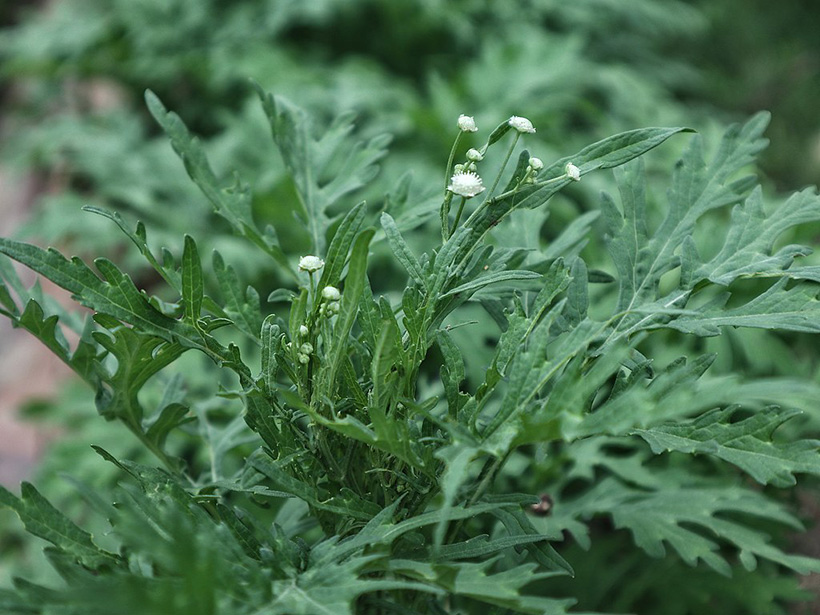Atmospheric levels of carbon dioxide (CO2) are the highest they’ve been in 800,000 years, and they are rising. Since the beginning of the Industrial Age, CO2 levels have increased nearly 50%. The consequences of increased levels of atmospheric CO2 are numerous and have far-reaching negative impacts, including on agriculture, climate, and human health, among others. To make matters worse, once CO2 is added to the atmosphere, it sticks around for hundreds to thousands of years.
Although increasing CO2 levels affect Earth and much of its life, plants are particularly sensitive to variations in these levels. They rely on the gas for survival, and changing carbon concentrations can affect everything from their growth rate to their nutritional value to their toxicity. Some hardy species are benefiting from current conditions, including an invasive plant known as famine weed (Parthenium hysterophorus). New research published in Nature Plants shows that one type of this toxic weed became more lethal under current CO2 levels, possibly making it more competitive and invasive.
Plants in a Carbon-Rich Atmosphere
“The question was, Why is one [famine weed biotype] spreading all over the place and the other is just kind of hanging out?”
Famine weed is a flowering plant native to Central and South America but has become an invasive species in parts of Africa, Australia, and the Indian subcontinent. Interestingly, two biotypes of famine weed were introduced into Australia in the 1950s, but only one flourished in its new home.
“The question was, Why is one spreading all over the place and the other is just kind of hanging out?” asked Julie Wolf, a plant physiologist at the U.S. Department of Agriculture and the corresponding author of the study.
According to the international research team that examined how the increase in atmospheric CO2 over the past 170 years has likely changed the biochemistry of the two types of native famine weed plants, the answer lies in one of the organism’s less appealing traits. Famine weed produces a particularly nasty, carbon-based toxin called parthenin that prevents other plants from growing around it. It can also cause severe skin irritation and asthma in humans. This toxin is thought to contribute to the prolific spread of the plant by killing competing plants and possibly deterring predation.
“The current invasiveness and nastiness of [the invasive biotype] is probably being exacerbated to some degree by current CO2 levels.”
At current CO2 levels, the invasive biotype produced more toxin by mass than the noninvasive biotype and more toxins than at preindustrial carbon levels, Wolf said. “The current invasiveness and nastiness of [the invasive biotype] is probably being exacerbated to some degree by current CO2 levels,” she said. With the increasing availability of carbon, it is easier for the invasive biotype to grow larger and produce more carbon-based toxin, possibly leading to its increased competitiveness, Wolf explained. The chemistry of the invasive biotype has probably adapted to use high levels of CO2 to its advantage, the authors say.
Focusing on the Future, Overlooking the Past
Further tests will be needed to see how famine weed fares as CO2 levels continue their upward climb, but the implications of its current adaptation are much broader. Danielle Way, a plant physiologist and associate professor at Western University who was not a part of the study, said this research illustrates that the selective pressure of the current level of atmospheric carbon may have already begun to favor carbon-adapted plants. These adaptations may have gone unnoticed because plant-response research has focused on future CO2 changes over the change we have already created.
“What have we already done to our system that is maybe passing under the radar because we’re really focusing on those even larger changes in CO2 and climate that we expect over the next 50 to 100 years?” Wolf asked. Unfortunately, the plants best equipped to thrive in these new conditions may not be the most beneficial to humans. “A plant that is successful in terms of persisting persists in the best way it can, and that might not match what we want from the plants,” said Wolf.
“A lot of times, people uniformly think that CO2 will be a benefit for plants, but it’s very much more diverse and varied.”
That doesn’t mean only increased toxicity. Other research studying plant responses in even higher CO2 environments has found that for many food crops, although the size of the plant increased, its nutritional value decreased. When grown under high levels of CO2, species like wheat and rice end up with less protein and lower concentrations of micronutrients even though the individual grains can be larger in size.
Predicting exactly which plants will flourish in an increasingly CO2-rich world is difficult. “A lot of times, people uniformly think that CO2 will be a benefit for plants, but it’s very much more diverse and varied,” Wolf said. She hopes that this work will act as an alarm bell, pushing the community to investigate how plants have already changed in our current, carbon-rich atmosphere to learn what the future holds. Otherwise, we risk a planet rendered increasingly inhospitable not only by temperature and climate but also by the species we share it with.
—Fionna M. D. Samuels (@Fairy__Hedgehog), Science Writer
This news article is included in our ENGAGE resource for educators seeking science news for their classroom lessons. Browse all ENGAGE articles, and share with your fellow educators how you integrated the article into an activity in the comments section below.
This piece was produced with support from the National Association of Science Writers’ David Perlman Virtual Mentoring Program.
Citation:
Samuels, F. M. D. (2021), Famine weed becomes more toxic, invasive in carbon-rich atmosphere, Eos, 102, https://doi.org/10.1029/2021EO163272. Published on 22 September 2021.
Text © 2021. The authors. CC BY-NC-ND 3.0
Except where otherwise noted, images are subject to copyright. Any reuse without express permission from the copyright owner is prohibited.


